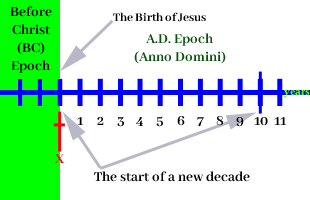John Foo:
the first decade was from year 1 to year 10 included. There was no year 0.
That's a tricky-trap riddle which let me thinking for a long time :-) After it, I still suppose you may be wrong.
The most important point here is truly about
year 0.
The Gregorian calendar most of the world uses nowadays, counts its start from the Birth of Jesus. Respectively, the Epoch before this event is BC (Before Christ) and the Epoch after (which we are living in now) is A.D. (Anno Domini).
This calendar era is based on the traditionally reckoned year of the conception or birth of Jesus, AD counting years from the start of this epoch and BC denoting years before the start of the era.
There is no year zero in this scheme; thus the year AD 1 immediately follows the year 1 BC.So far so good, but the illustration here gives the point:

There's no year zero, but definitely, there's a mark which could be called "Zero" (on my drawing it's
X). It's like on any ruler or roulette, you couldn't measure 1 inch or 1 centimeter without having a clue where the 0 mark is.
Similarly here, we could define that Jesus was born
in the year 1 A.D., but it only means His birth is between the X and the 1 on this time line. Also, if something happened in the same year 1 A.D., it happened
between X and 1 on this time line.
We obviously can't define X=1 as it would mean, we count everything
prior to it really happened.
In our case, "0" is the date/year/time when Jesus Christ was born, and this meant the start of the new Epoch, and thus definitely the new decade. When we pass each year 10 in this scheme, it means the previous decade is over and we start the new one immediately. The old decade and the new decade meat each other on this time segment.
Alas Internet lacks graphical illustrations of how it all could be present; also there is year Zero in
Astronomical year numbering. But since the question is only about
when the new decade is started, I hope I've given enough of proofs.


 Page 1 of 2 : 2 Next »
Page 1 of 2 : 2 Next » Page 1 of 2 : 2 Next »
Page 1 of 2 : 2 Next » 